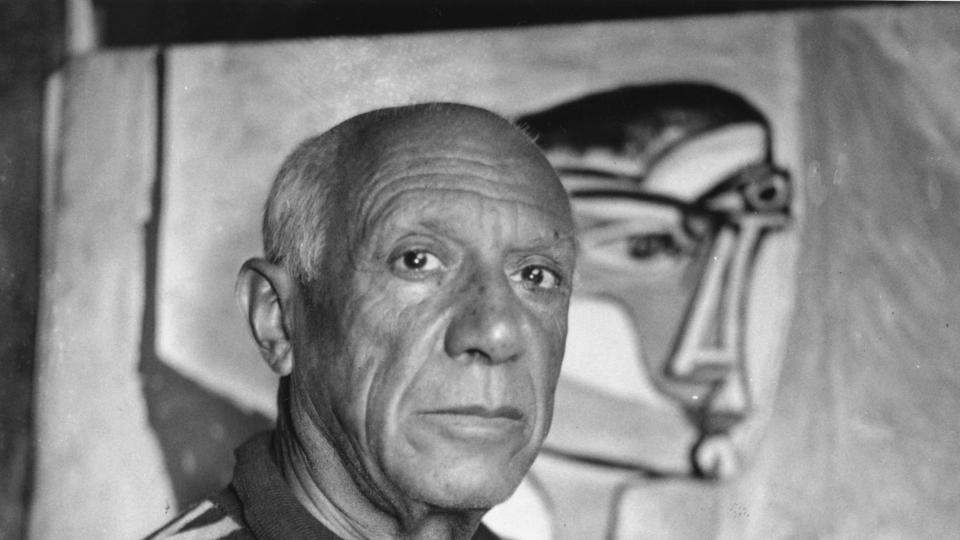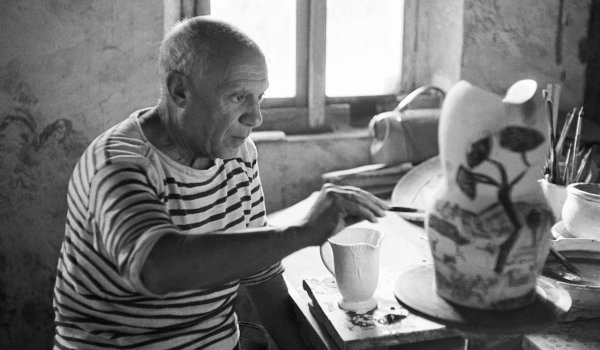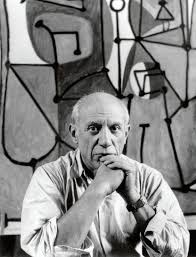
1881 - 1973
Pablo Picasso

description
Pablo Picasso was a Spanish and French artist, sculptor, graphic artist, theatre artist, ceramicist and designer. He was the founder of Cubism (together with Georges Braque and Juan Gris), in which the three-dimensional body was drawn in an original manner – as a series of superimposed planes. Also, it is known that his paintings hold first place in “popularity” among thieves.
Picasso began painting when he was a child. According to his mother, his first words were “piz, piz”, a shortening of lápiz, the Spanish word for “pencil”. His first painting teacher was his own father, artist José Ruiz y Blasco. At the age of 8, a young Pablo created his first oil painting “Picador”, which he would keep with him throughout his life. Having moved to northern Spain, he studied at a local art school. After that, he went to an art school in Barcelona.
Picasso’s work can be categorized into a few periods:
Blue period (1901-1904).
Rose Period (1904–1906).
African art and primitivism (1907–1909).
Analytic Cubism (1909–1912).
Synthetic Cubism (1912–1919).
Neoclassicism and surrealism (1919–1929).
The Great Depression (1930–1939).
World War II and late 1940s (1939–1949).
Later works (1949–1973).
The total number of artworks Pablo produced has been estimated at 50,000, consisting of 1,885 paintings, 1,228 sculptures, 2,880 ceramics, roughly 12,000 drawings, many thousands of prints, and numerous tapestries and rugs.
The work of Picasso significantly influenced the development of 20th-century art. In the 1960s, the Paris Picasso Museum opened. It is housed in five mansions. In 2003, the Picasso Museum was opened in the artist’s hometown of Malaga. Picasso’s works remain the world’s most expensive paintings.
Key ideas:
– During the Blue period, Picasso was impressed by paintings from the Impressionists and started using a bright palette and clear contour lines. Blue shades predominated his early palette. His works from this era touched on the themes of old age, death, poverty, melancholy and sadness. As Picasso himself said, “those who are sad are sincere.” Picasso mostly drew blind people, beggars, alcoholics and prostitutes.
– During the Rose period, Picasso depicted circus artists: clowns, dancers and acrobats. He became interested in this topic after settling down in Paris. The artist gave preference to pink colours. His paintings from this period are infused with the tragic loneliness that accompanied the destitute, romantic life of wandering comedians.
– In 1907, Picasso first saw archaic African art at an ethnographic exhibition at the Trocadero Museum. Having admired those works, he paid tribute and simplified their shapes, making his characters resemble wood or stone idols. The characters of the artist’s paintings, like many African tribes, are very close to nature. This period lasted until 1909 and was named the “period of African art and primitivism”.
– In 1909, the artist started developing Analytic Cubism, using monochrome brownish and neutral colours. He took apart objects and “analyzed” them in terms of their shapes. Special attention was paid to the transformation of shapes into geometric blocks. Increasing fragments, the artist “broke” objects, dissecting them on canvases. Picasso considered this space to be a “solid body”, limited by the plane of the canvas. Women became frequent “victims” of the methods of “dismembering” models and experiments with colour. They often looked disturbing.
– Synthetic Cubism (1912–1919) was a further development in the genre of Cubism. Picasso rejected the idea of a window to the world and began to interpret it as the arrangement of signs. He used various, sometimes metaphorical, materials to refer to these objects, unusual fonts for signs, numbers and words. Paper fragments – often wallpaper or portions of newspaper pages – were cut and pasted into compositions, marking the first use of collage in fine art. However, all this made Picasso’s paintings appear like abstract art. The artist was not satisfied with this, and as a result, lost interest in Cubism a few years later.
– During the Neoclassicism period, Picasso realized that he was interested in painting only. “Art never makes me tired. I could not live without giving all my time to it. I love it as the only goal of my life.”
– In post-war Paris, euphoria dominated and the overall success of society induced the artist to return to figurativeness. Nevertheless, since Picasso continued to do many cubist still-lifes, this was temporary.
– Surrealism revived Picasso’s attraction to primitivism and eroticism. He developed new imagery and formal syntax for expressing himself emotionally.
– In the late period, Picasso – who had always respected the classics – turned to his beloved artists of the past and drew modern canvases, using compositions of Velazquez, Rembrandt, Poussin, Goya and Enger. He also led explicit artistic dialogues with Courbet, Manet and others.
1881
1895
1897
1900
1902
1904
1907
1910
1916
1925
1937
1949
1950
1973
The birth of the genius
Picasso entered the Fine Arts School of La Lonja

He entered the Royal Academy of Fine Arts of San Fernando

The artist went to Paris

"The Blue Period"

“The Rose Period ”

Cubism

The Synthetical period

The artist took part in the production of an innovative “surreal” ballet called “Parade”

The difficult period of his career

Dreams and lies of Franco”, Guernica”

Created numerous family paintings

Picasso painted his “Dove of Peace”, which became world-famous.

The death of the artist

Pablo Picasso
On Artist
flow
Classicism
Impressionism
friends
George Braque
Patrick Henry Bruce
Constantin Brancusi
Man Ray
Max Jacob
Christopher Wood
Mikhail Boychuk
Carlos Casagemas
Jaime Sabartes
artists
Louis Anketen
Emile Bernard
Henri de Toulouse-Lautrec
Edouard Manet
Henri Matisse
Edvard Munch
Gustave Courbet
Mark Shagal
Henri Rousseau
El Greco
Francisco de Goya
Paul Gauguin
Paul Cezanne
Auguste Rodin
Nicolas Poussin
Pierre Auguste Renoir
Jose Ruiz Blasco
By Artist
flow
Surrealism
Abstract expressionism
Cubism
Pop Art
Conceptualism
friends
George Braque
Lado Gudiashvili
Kes van Dongen
Jean Metzinger
Lev Bakst
Patrick Henry Bruce
Constantin Brancusi
Man Ray
Max Jacob
Christopher Wood
Mikhail Boychuk
artists
Kazimir Malevich
Diego Rivera
George Valmier
Louis Marcoussis
Max Weber
Roger de la Freinet
Mark Shagal
Amedeo Modiglian
Willem de Kuning
Jasper Johns
Arshil Gorki
Lee Krasner
Jackson Pollock
Robert Delone
Pete Mondrian
Karel Appel
Balcomb Green
Francis Bacon
David Alfaro Siqueiros
Salvador Dali
Tamara de Lempicka
Vilhelm Lundstrom
